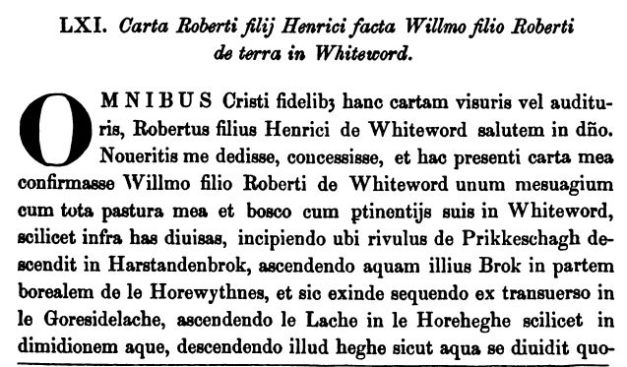The most famous medieval boundary in the region is the Nico Ditch, but there are many other medieval references to boundaries, usually ditches. There were many references to natuaral boundaries too, such as rivers and streams.
Ditches
The Nico Ditch was mentioned in the 12th C. it is the longest recorded ditch in the region. Read more about the Nico Ditch here.
Ditches mentioned in the Coucher Book of Whalley
There are many references to man made boundaries in the Coucher Book of Whalley Abbey, here are some examples.
Rochdale castle ditch
Rochdale’s castle was in a commanding position overlooking the confluence of the Roche and Spodden rivers, and the route to Manchester. The charter transcribed in medieval Latin and published well over a hundred years ago, is from volume 2 of the Coucher Book of Whalley Abbey. The charter refers to “Merlond,” modern Marland, and Castleton. The castle ditch in Latin is “fossatum castelli” in the extract below.

Rochdale castle – the castle ditch
TBC
Parish Boundaries
Parish surveys usually started by defining the features used to delimit the parish. These could be streams, ditches or lanes, for example. These features were still used in the post medieval period, in this survey of Rochdale from 1610, summarised here, you can still read the names of features first mentioned in medieval charters and other documents.
Boundary Stones or “Meres”
Large stones were often used as boundary markers between townships or parishes, such as open heaths or moorland.
Here is a 16th Century reference to the size of stones used to mark the boundary of Rochdale and Oldham, near Buersill.
“Sir John Byron caused “divers great stones, every stone as
much as twenty oxen could draw,” to be set up much within the
boundary line of Hathershaw moor, and if not removed will soon be
taken to be the “meres” rightly set up between the two wastes . Sir
John Byrori s reply to this was to the effect that he was seised as of
fee of his “own severall enherytance” in Buersill moor, which was
divided from Hathershaw by certain “meyers” which by the informers or
other “evilly disposed persons” have been removed, and to remedy this
he had obtained the writ as set forth by the plaintiffs, and by virtue of
it Sir John Atherton caused “certain honest persons” to make the
perambulation and set the ” meyers ” in such places as they had always
been ; since then he had caused to be placed on his own lands certain
stones that the boundaries might be the better known.”
Fishwick description of a 1552 Duchy of Lancaster Court case from the History of the Parish of Rochdale – Castleton Township.
Natural Boundaries
Rivers were often used as boundaries, the river Mersey means boundary river. Prominent rocks or large stones were used as well, the “Wolf Stone” in Naden near Rochdale, for example.
Rivers
Rivers were often used as boundaries and are amongst some of the earliest places mentioned in medieval documentation of the region. The name Mersey, as in the river Mersey means boundary river, according to Ekwall and other place-name experts.
Fords
A ford over the river Roche was called “Irreford” in medieval times. This led Ekwall to wonder if the Roche was originally called “Irre” similar name to the nearby Irwell and Irk rivers.
Lakes
Lakes were an important source of fish as well as being a natural landmark. Marland in Rochdale was owned by Whalley Abbey, while Lake Kor near Prickshaw in Whitworth was mentioned in a medieval charter in the Coucher Book of Whalley Abbey. Sadly both lakes have gone, the former was in what is now Marland Park, the latter may be where the ponds east of Prickshaw are now.
Ashworth – an example of medieval boundaries and disputes.
Ashworth was a township of the Parish of Middleton, due to the detached portions (parish districts. distant from, but not connected to the main parish) of Middleton Parish boundaries were complex, perhaps some of the most complex in England. There are detached portions that
There are many references to boundaries and boundary disputes in Ashworth, several are mentioned in the footnotes of the Chapter here.
Note
There is a 1287 reference to ‘syke,’ a dialect word for an artificial ditch usually dug as a boundary, see footnote 11 here.
There was also a well documented dispute in the 16th C. also documented in the Ashworth Township chapter.
Under construction…













